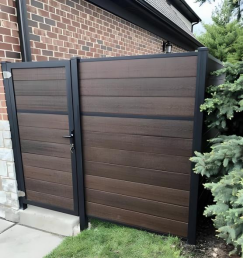

When it comes to the choice of outdoor fencing, the advantages of materials, production efficiency, and changes in market demand are always the key considerations. In recent years, aluminum alloy outdoor fencing has gradually emerged and is on the verge of replacing WPC wood-plastic composite fencing. Next, let's delve into this trend from the aspects of material advantages, production efficiency, and outdoor market demand.


Aluminum alloy possesses excellent strength and hardness. In contrast, although WPC wood-plastic composite fencing can withstand certain levels of daily wear and tear, during long-term use, especially when facing extreme situations such as strong winds and heavy object impacts, its performance is often inferior to that of aluminum alloy fencing. The high strength of aluminum alloy enables it to withstand greater external forces without deformation or damage, thereby prolonging the service life of the fencing.
The outdoor environment is complex and variable, with rain, sunlight, and humid air all causing corrosion to the fencing. The surface of aluminum alloy fencing undergoes special oxidation treatment or coating processes, which can form a firm protective film, effectively resisting various corrosive factors. However, WPC wood-plastic composite fencing may develop problems such as mold and rot in long-term humid environments, affecting its appearance and service life.
In terms of fire safety, aluminum alloy fencing has significant advantages. Aluminum alloy is a non-flammable material that can maintain the stability of the structure during a fire and reduce the risk of fire spread. In contrast, WPC wood-plastic composite fencing is a combustible material and may contribute to the fire once a fire occurs, posing a threat to life and property safety.
Aluminum alloy fencing can achieve a wide variety of colors and textures through advanced surface treatment technologies, such as wood grain, brushed, and matte, which can meet the individualized appearance needs of different consumers. Moreover, the color stability of aluminum alloy is better, and it is not prone to fading. The color choices of WPC wood-plastic composite fencing are relatively limited, and the color may fade easily under long-term sunlight exposure.
The processing technology of aluminum alloy is relatively mature. Through methods such as die-casting and extrusion molding, efficient and large-scale production can be achieved. In contrast, the production process of WPC wood-plastic composite fencing is relatively complex, requiring the mixing of plastic and wood powder and extrusion molding, resulting in lower production efficiency.
Aluminum alloy is a widely used metal material with an abundant supply of raw materials and relatively stable prices. This ensures a stable supply for the production of aluminum alloy fencing and is not affected by shortages of raw materials. However, the supply and prices of raw materials such as plastic and wood powder used in WPC wood-plastic composite fencing may be influenced by market fluctuations, causing certain uncertainties in production.
The structure of aluminum alloy fencing is typically simpler, and the installation process is relatively quick. Its standardized component design enables installation workers to complete the installation work in a shorter period, improving construction efficiency. In contrast, the installation of WPC wood-plastic composite fencing may require more steps and time, increasing construction costs.

With the continuous improvement of people's environmental awareness, the focus on sustainable development has been increasing. Aluminum alloy is a recyclable material, meeting environmental protection requirements. When the service life of aluminum alloy fencing is reached, it can be recycled and reprocessed to achieve the recycling of resources. While WPC wood-plastic composite fencing, although reducing the reliance on wood to a certain extent, still faces difficulties in the recycling and disposal of its plastic components.
In the high-end outdoor fencing market, consumers have higher requirements for quality and appearance. Aluminum alloy fencing, with its superior performance and exquisite appearance, can meet the needs of this group of consumers. In contrast, WPC wood-plastic composite fencing has relatively weak competitiveness in the high-end market.
With the acceleration of the urbanization process, the demand for outdoor fencing in urban public facilities and real estate projects is constantly increasing. The high strength, durability, and aesthetics of aluminum alloy fencing make it an ideal choice in urban construction. However, WPC wood-plastic composite fencing may not fully meet the strict requirements for quality and performance in large-scale urban construction projects.
To sum up, aluminum alloy outdoor fencing demonstrates obvious advantages in material advantages, production efficiency, and outdoor market demand. Its high strength, corrosion resistance, fire resistance, and rich appearance options enable it to maintain a good state for a long time in harsh outdoor environments. The efficient production process and convenient installation methods help reduce costs and improve production efficiency. At the same time, the market's pursuit of environmental protection, high quality, and sustainable development also provides broad space for the development of aluminum alloy fencing.
It can be predicted that in the future outdoor fencing market, aluminum alloy fencing will gradually occupy a dominant position and become the first choice for consumers. WPC wood-plastic composite fencing, on the other hand, needs continuous innovation and improvement to adapt to market changes and demands. As consumers and industry practitioners, we should closely follow this trend and make positive contributions to creating a more beautiful, practical, and sustainable outdoor environment.
Email format error
Email cannot be empty
Email already exists
6-20 characters(letters plus numbers only)
The password is inconsistent
Email format error
Email cannot be empty
Email does not exist
6-20 characters(letters plus numbers only)
The password is inconsistent